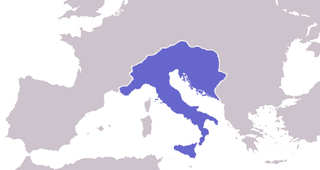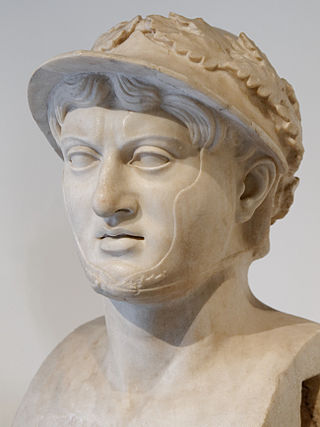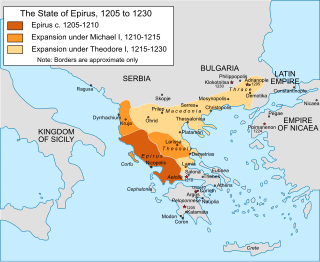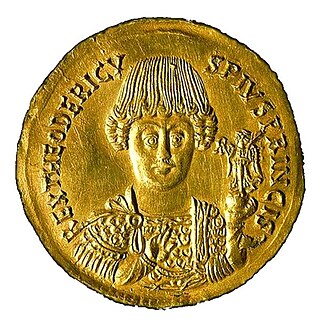
Alexander I of Epirus, also known as Alexander Molossus, was a king of Epirus (343/2–331 BC) of the Aeacid dynasty. As the son of Neoptolemus I and brother of Olympias, Alexander I was an uncle, and a brother-in-law, of Alexander the Great. He was also an uncle to Pyrrhus of Epirus.

The Ostrogoths were a Roman-era Germanic people. In the 5th century, they followed the Visigoths in creating one of the two great Gothic kingdoms within the Roman Empire, based upon the large Gothic populations who had settled in the Balkans in the 4th century, having crossed the Lower Danube. While the Visigoths had formed under the leadership of Alaric I, the new Ostrogothic political entity which came to rule Italy was formed in the Balkans under the influence of the Amal dynasty, the family of Theodoric the Great.

Theodoricthe Great, also called Theodoric the Amal, was king of the Ostrogoths (471–526), and ruler of the independent Ostrogothic Kingdom of Italy between 493 and 526, regent of the Visigoths (511–526), and a patrician of the Eastern Roman Empire. As ruler of the combined Gothic realms, Theodoric controlled an empire stretching from the Atlantic Ocean to the Adriatic Sea. Though Theodoric himself only used the title 'king' (rex), some scholars characterize him as a Western Roman Emperor in all but name, since he ruled large parts of the former Western Roman Empire, had received the former Western imperial regalia from Constantinople in 497, and was referred to by the title augustus by some of his subjects.

Year 493 (CDXCIII) was a common year starting on Friday of the Julian calendar. At the time, it was known as the Year of the Consulship of Albinus and Eusebius. The denomination 493 for this year has been used since the early medieval period, when the Anno Domini calendar era became the prevalent method in Europe for naming years.

Epirus is a geographical and historical region in southeastern Europe, now shared between Greece and Albania. It lies between the Pindus Mountains and the Ionian Sea, stretching from the Bay of Vlorë and the Acroceraunian Mountains in the north to the Ambracian Gulf and the ruined Roman city of Nicopolis in the south. It is currently divided between the region of Epirus in northwestern Greece and the counties of Gjirokastër and Vlorë in southern Albania. The largest city in Epirus is Ioannina, seat of the Greek region of Epirus, with Gjirokastër the largest city in the Albanian part of Epirus.

Totila, original name Baduila, was the penultimate King of the Ostrogoths, reigning from 541 to 552 AD. A skilled military and political leader, Totila reversed the tide of the Gothic War, recovering by 543 almost all the territories in Italy that the Eastern Roman Empire had captured from his Kingdom in 540.

Pyrrhus was a Greek king and statesman of the Hellenistic period. He was king of the Greek tribe of Molossians, of the royal Aeacid house, and later he became king of Epirus. He was one of the strongest opponents of early Rome, and had been regarded as one of the greatest generals of antiquity. Several of his victorious battles caused him unacceptably heavy losses, from which the term "Pyrrhic victory" was coined.

King of Italy was the title given to the ruler of the Kingdom of Italy after the fall of the Western Roman Empire. The first to take the title was Odoacer, a barbarian military leader, in the late 5th century, followed by the Ostrogothic kings up to the mid-6th century. With the Frankish conquest of Italy in the 8th century, the Carolingians assumed the title, which was maintained by subsequent Holy Roman Emperors throughout the Middle Ages. The last Emperor to claim the title was Charles V in the 16th century. During this period, the holders of the title were crowned with the Iron Crown of Lombardy.

Nicopolis or Actia Nicopolis was the capital city of the Roman province of Epirus Vetus. It is located near Preveza, Greece. The city was founded in 29 BC by Octavian in commemoration of his victory in 31 BC over Antony and Cleopatra at the Battle of Actium nearby.

The Despotate of Epirus was one of the Greek successor states of the Byzantine Empire established in the aftermath of the Fourth Crusade in 1204 by a branch of the Angelos dynasty. It claimed to be the legitimate successor of the Byzantine Empire, along with the Empire of Nicaea and the Empire of Trebizond, its rulers briefly proclaiming themselves as Emperors in 1227–1242. The term "Despotate of Epirus" is, like "Byzantine Empire" itself, a modern historiographic convention and not a name in use at the time.
Ptolemy, king of Epirus was the second son of Alexander II, king of Epirus, and Olympias, grandson of the great Pyrrhus and brother of Phthia of Macedon. He was named in honour of his late uncle Ptolemy. He succeeded to the throne on the death of his elder brother, Pyrrhus II of Epirus, but reigned only a very short time, having set out on a military expedition, during the course of which he fell sick and died or, according to Polyaenus, he was treasonably assassinated. The date of his reign cannot be fixed with certainty, but as he was a contemporary of Demetrius II, king of Macedonia, it may be placed between 239 and 229 BC. He was succeeded by Deidamia II or Pyrrhus III.

The Ostrogothic Kingdom, officially the Kingdom of Italy, existed under the control of the Germanic Ostrogoths in Italy and neighbouring areas from 493 to 553.
Neoptolemus I of Epirus was a Greek king of Epirus and son of Alcetas I, and father of Troas, Alexander I of Epirus and Queen Olympias. He was the maternal grandfather of Alexander the Great. He claimed he was a descendant of hero Achilles and King Lycomedes, while Emperor Caracalla claimed that he was a descendant of Neoptolemus I. Olympias was originally known as Polyxena and it is possible that Neoptolemus gave her that name.

Epirus was an ancient Greek kingdom, and later republic, located in the geographical region of Epirus, in parts of north-western Greece and southern Albania. Home to the ancient Epirotes, the state was bordered by the Aetolian League to the south, Ancient Thessaly and Ancient Macedonia to the east, and Illyrian tribes to the north. The Greek king Pyrrhus is known to have made Epirus a powerful state in the Greek realm that was comparable to the likes of Ancient Macedonia and Ancient Rome. Pyrrhus' armies also attempted an assault against the state of Ancient Rome during their unsuccessful campaign in what is now modern-day Italy.
Eutharic Cilliga was an Ostrogothic prince from Iberia who, during the early 6th century, served as Roman Consul and "son in weapons" alongside the Byzantine emperor Justin I. He was the son-in-law and presumptive heir of the Ostrogoth king Theoderic the Great but died in AD 522 at the age of 42 before he could inherit Theoderic's title. Theoderic claimed that Eutharic was a descendant of the Gothic royal house of Amali and it was intended that his marriage to Theoderic's daughter Amalasuintha would unite the Gothic kingdoms, establish Theoderic's dynasty and further strengthen the Gothic hold over Italy.

Flavius Boethius was a Roman politician during the Ostrogothic kingdom in Italy.

The House of Tocco was an Italian noble family from Benevento that came to prominence in the late 14th and 15th centuries, when they ruled various territories in western Greece as Counts Palatine of Cephalonia and Zakynthos and Despots of Epirus. During their brief period of rule in Greece, they were one of the most ambitious and able Latin dynasties in the region, and they were one of the few to leave descendants lasting until modern times.
Dagistheus was an Ostrogothic chieftain. The name is Germanic. Theodoric the Great sent Dagistheus and Soas as hostages to Adamantius in Epirus in 479. He was presumably a leading Ostrogothic chieftain under Theodoric. The Roman baths in Constantinople were possibly named after him. He may have been an ancestor of the later Byzantine general Dagisthaeus.

The province of Epirus was a province of the Roman Empire, covering the region of Ancient Epirus. Rome first annexed the region in 167 BC, in the aftermath of the Third Macedonian War, and initially put the region in the larger Roman province of Macedonia, which at the time covered the whole of the Hellenistic world in mainland Europe. In 27 BC, Epirus and Achaea were separated from Macedonia and grouped into the senatorial province of Achaea, with the exception of its northernmost part, which remained part of the province of Macedonia. Under Emperor Trajan, sometime between 103 and 114 AD, Epirus became a separate province, under a procurator Augusti. The new province extended from the Gulf of Aulon (Vlorë) and the Acroceraunian Mountains in the north to the lower course of the Acheloos River in the south, and included the northern Ionian Islands of Corfu, Lefkada, Ithaca, Cephallonia, and Zakynthos.
Gento was a 5th-century Gothic warrior in Eastern Roman service. He was married to a Roman woman from Epirus, and the commander of a unit of Roman troops. In 479, when Theodoric the Great attempted to settle the Ostrogoths in Epirus with the help of his relative Sidimund, Gento and the Eastern Roman general Sabinianus were tasked with preventing it.













